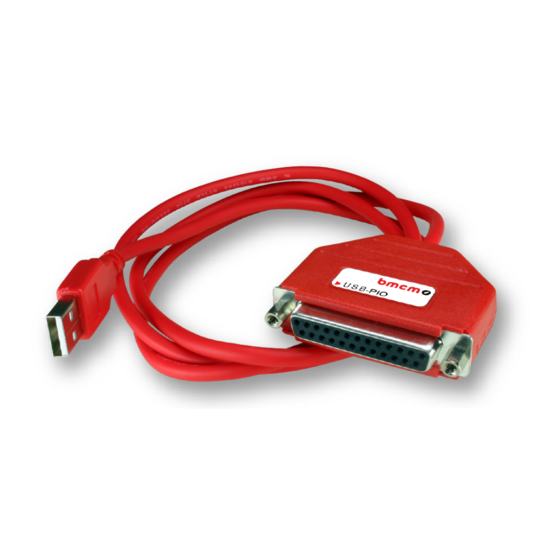
Advertisement
USB-PIO
Digital I/O Interface (USB)
24 Channels. Digital.
Signal Output & Monitoring.
Record and output digital TTL signals. The
USB-PIO features three 8-bit bidirectional
ports. The port lines are led out to a 25-pin D-
Sub female connector.
Extra Small. Extra Red.
Extra Low-Priced.
The unique idea of the USB-PIO: the device is
accommodated in the D-Sub connector
housing. Not only the size is extra small but
also the price.
Plug & Play.
The connection to the PC is realized via USB.
The USB-PIO provides all typical USB features
(e.g. Plug&Play, Hot-Plug). Up to 127 devices
can be connected and installed during
operation.
Powered by USB.
The device is supplied with power via the USB
interface. This reduces cabling efforts to a
minimum and makes mobile measurements a
lot easier.
Functional diagram and pin assignment
Open for Everyone.
Widely supported: The USB-PIO can be used
under Windows
®
XP/7/8/10 as well as under
Mac OS X, Free BSD, and Linux. The
complete software for installation and
programming of the device is included for free.
NextView
. Try for Free.
®
The DAQ system is supported by NextView
the software for data acquisition and analysis.
A fully functional 14-day trial is included with
delivery to directly test the functionality of the
USB-PIO.
Get Connected.
Various optocoupler and relay cards are
available at bmcm to electrically isolate the
digital lines. For the USB-PIO it is particularly
easy as only a 25-pin D-Sub extension cable
is needed for connecting.
,
®
Advertisement
Table of Contents

Summary of Contents for bmcm USB-PIO
- Page 1 Mac OS X, Free BSD, and Linux. The complete software for installation and Extra Small. Extra Red. programming of the device is included for free. Extra Low-Priced. The unique idea of the USB-PIO: the device is NextView . Try for Free. ® accommodated in the D-Sub connector The DAQ system is supported by NextView ®...
-
Page 2: Start-Up Procedure
USB-PIO 1 Start-up procedure All available software and documentation for the USB-PIO are located on www.bmcm.de/usb-pio-en in the tab Downloads. 1. Step: Installation device driver Install the latest driver package in order to use the USB measurement device. You will find the package on www.bmcm.de/usb-pio-en... -
Page 3: Digital Inputs And Outputs
USB-PIO Digital Inputs and Outputs The USB-PIO features a µ-controller providing three 8-bit digital ports A, B, C. The lines are bidirectional. The direction is set to input or output in groups of 8 (port C: 4) via software. The following table and figure shows the pin assignment of the 25-pin D-Sub female connector of the USB-PIO, at which the digital lines are accessible. -
Page 4: Interfacing Examples
In this regard, please also see application examples of the optocoupler you use. Optocoupler cards featuring 8 inputs are available at bmcm (see chapter 6). 3.1.2 Connecting a Push-Button / Switch Please make sure to use a push-button with debounce protection, because otherwise several pulses might be recorded. - Page 5 Since the field coil of the relay requires a higher current than provided by the measurement system at one line, a transistor is connected ahead. Relay cards featuring 8 outputs are available at bmcm (see chapter 6). 3.2.3 Connecting a Lamp A transistor can be used to switch higher loads.
- Page 6 OUT (relay output) I/O (bidirectional) • The port direction of the USB-PIO must comply with the settings of the optocoupler/relay card to avoid damages (optocoupler channels to input, relay channels to output). • For further information, please see the relevant data sheets.
- Page 7 Do not dispose of the product in the domestic waste or at any waste collection places. It has to be either duly disposed according to the WEEE directive or can be returned to bmcm at your own expense. Page 7...
-
Page 8: Technical Data
Delivery: connecting cable ZUKA25, 25-pin D-Sub plug ZU25ST, optocoupler/relay cards OR8, R8 Available accessories (optional): 2 years from date of purchase at bmcm, claims for damages resulting from improper use excluded Warranty: • Software LIBAD4 SDK for C/C++ programming on Windows XP/7/8/10, Mac OS X, Unix (FreeBSD, Linux);...



Need help?
Do you have a question about the USB-PIO and is the answer not in the manual?
Questions and answers